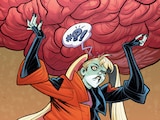With last week’s release of its big screen adaptation, I really wanted to revisit the comic book series that inspired the movie and gave a fresh new take on the beloved mob genre.
The Kitchen, written by Ollie Masters and drawn by Ming Doyle, is a gritty crime-ridden comic that entirely flips the script on the traditional mob story. Most of these stories (like 99% of them) are male dominated and have very few or no female leads at all, but in The Kitchen, we get a unique one that asks, “What if women took over and led the Irish Mob?”

It all takes place in 1970s Hell’s Kitchen where three mob wives named Kathy, Raven and Angie (the last two were changed for the movie) decide to take over their husbands’ jobs after they’re sent to prison. It’s not really a matter of them necessarily wanting to do this, at least at first, but they’re so deeply affiliated with the mob that it’s really their only means of survival.
While their husbands are in jail, the three wives rely on the new boss to provide for them financially, but they start to notice that their money is consistently coming in short. Kathy has kids to look after so she’s the first of the three wives to suggest taking over the collections in order to help make ends meet and uphold the credibility and respect of their husbands’ work.
Even with initial pushback from Raven and Angie, they all step up and start collecting money together and end up running the collections so much better than their gangster husbands ever could. That doesn’t mean it comes to them easily. In a world as steeped in tradition and sexism as the Irish underworld, they have to earn the respect from the same people who did business with their husbands and prove to them that they aren’t weak because in this business, weak people don’t survive very long.

Pivotally, all three wives go through a transformative moment in the comic in which they transcend from being a housewife living in the shadow of their husbands to being a full-fledged mob boss running Hell’s Kitchen. These particular moments are my favorite parts of this series because they show how the women individually take on unique roles that immerse them in this world of money, power, betrayal and murder.
Kathy’s moment comes when she pistol whips a man into a bloody pulp and shoots his ear off after he slapped her and refused to give her the money he owed. Angie’s comes as a direct result of Kathy’s altercation—someone had seen what happened and threatened to snitch on them if they didn’t pay a bribe. Angie beats this man to death with a ceramic ash tray. She knew that they were already in too deep after what happened, and came to the realization that accepting this new life would give them the chance to exist in the world in a different way.
The moment of Raven’s transformation isn’t as clear cut as the other two, but it’s definitely one of the more interesting ones. She becomes deeply entangled in the business side through her connections with higher members of the Irish mob and ultimately becomes the one who's calling the shots. In many ways, Raven has the most dramatic transformation out of them all, and as the story goes on, ends up killing and hurting the people that she loves the most. Also, there’s a dramatic scene where she dyes her hair blonde. I can attest that once a girl dyes her hair a dramatic new color, that’s how you know it’s over for you.

Together, Kathy, Raven and Angie build their empire into something so much greater than it was under their husbands. So it’s not surprising that when their husbands were released from jail, the girls had no intention of giving them their business back.
During this time, we see the tension between Kathy and Raven escalate—something that’s also present in the film. In the comic, Kathy and Raven are sisters that grew up knowing all about the mob because of the ties their family had in it. It was never really a choice for them, they were forced to be a part of it whether they liked it or not. Initially, Kathy was the one who wanted to get involved and Raven was the one pushing back the most.
Unsurprisingly, Kathy is the first to show her brutality, but later mellows out and still shows signs of having some humanity when it comes to protecting her children and a high school friend of hers who’s a struggling addict. In contrast, Raven starts reluctant, but finds herself racing to point of no return, succumbing completely to the mob life and killing anyone getting in the way of her and her business without hesitation. It’s interesting to see how the power dynamic shifts between the two of them and completely ruins their relationship as sisters.

Overall, The Kitchen owns the mob genre and adds to it by giving it a complex female perspective for the very first time. Not only is the story female-centric, but it has a female artist. So much in this book is riding on the emotions and internal turmoil—or lack of it—within the characters, which makes drawing expressive, but believable faces particularly important, and Ming Doyle excels at it. Her gift at visual characterization and gritty realism helps elevate the attitude, emotion and intensity spoken in the dialogue in each panel. Even when no words are on the page, you can tell exactly what the character is feeling, whether it’s pain, regret, disgust or betrayal…all just by looking at their face.
Even though there are several male characters in this story, none of them shine the way that Kathy, Raven and Angie do. What starts off with a few wives handling collections for their husbands turns into them creating and running an entire criminal empire of their own. It’s absolutely worth revisiting this story again or reading it for the first time, especially if you’re planning on seeing The Kitchen in theatres.
The Kitchen by Ollie Masters, Ming Doyle and Jordie Bellaire is available in bookstores, comic shops and as a digital graphic novel. The movie adaptation, starring Melissa McCarthy, Tiffany Haddish and Elisabeth Moss, is now in theaters. Click here to buy tickets.
Lissete Gonzalez writes about film, TV and comics for DCComics.com and is a contributor to Couch Club, our weekly television column. Look for her on Twitter at @lissete74.




















